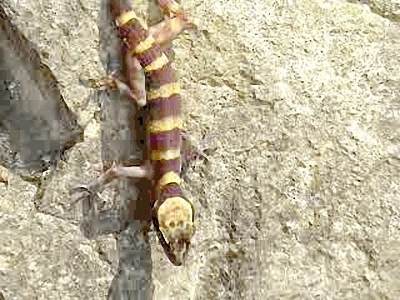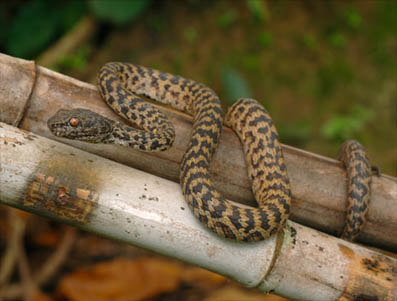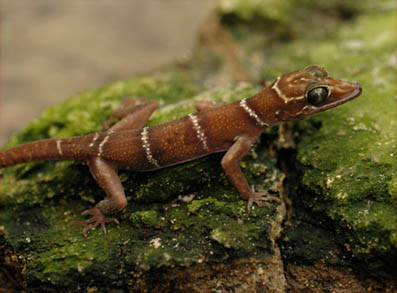
October 28, 2008

Gecko king: Ngo Van Tri, 39, examines a new species of lizard, one among his 300-plus collection of the small reptile. — VNS Photo Thanh Hieu
Malaria, emergency surgery – scientist Ngo Van Tri is willing to go to any lengths to discover more about lizards. The following report from reporter Thanh Hieu of the Viet Nam News, Vietnam News Agency, Hanoi, Vietnam finds out more.
Ngo Van Tri’s happiest moments are when he wanders the jungle or in deep caves and discovers a species of lizard he doesn’t have in his collection.
“The thrill and delight linger on for the next few days,” the 39-year-old Da Nang native says.
His collection runs to more than 300 species now, eight of which are endemic to Viet Nam and some have been published in prestigious specialised journals.

Ta Kou lizard (Cyrtodactylus takouensis).
These include Tuc Dup, the round-eyed gecko (Cnemaspis tucdupensis), white-tail, round-eyed gecko (Cnemaspis caudanivea), suffron leg, round-eyed gecko (Cnemaspis aurantiacopes), and Ta Kou Bent-toed Gecko (Cyrtodactylus takouensis), among others, all found in forests and caves across the country.
Huynh lizard (Cyrtodactylus huynhi)
He also discovered one species of the Hon Son Pitviper (Cryptelytrops honsonensis), a member of the rattlesnake [i.e. it is a pit viper] family.

The Hon Son pit viper [rattle-snake] (Cryptelytrops honsonensis sp. nov. Grismer, Ngô & Grismer, 2008).
Tri’s discoveries, published in scientific magazines like ZooTaxa and Herpetologica, have significantly contributed to knowledge about biodiversity in Viet Nam and the world.
Lizard aficionado
Tri said his passion for lizards began during a field trip when he found an abnormally-shaped lizard sticking to his shirt.
Quitting a well-paid job at the Fauna and Flora International’s (FFI) Indochina Programme, Tri has made hundreds of forays into forests and caves around the country from Bi Doup-Ba (Lady) Mountain in the Central Highlands province of Lam Dong to the far-flung southern islands of Tho Chu and Hon Khoai.
Tri has become so besotted with lizards, small members of the reptile family, which also includes snakes and amphibians, that he has spent more than 10 years studying them.
“Moreover, I am an adventurer who does not want to follow in others’ footsteps even though doing so will be easier and safer.”
Pointing to one lizard with two scratches on its sides, Tri recalls: “I caught this one in a steep dark cave after I had tripped over slippery rocks and broken my expensive camera. Despite my best efforts, this one was injured.”
Over the past 14 years that he has spent in pursuit of the reptiles, Tri says he has suffered from malaria 10 times and undergone emergency treatment three times.
He has been swept away by different rivers three times and once hustled into a waterfall by illegal loggers after being mistaken as an investigative journalist.
His right eye became short-sighted because a parasite clung to him as he was attempting to cross a river in high spate.
“At that time I did not feel pain at all but managed to return to the house of a local resident as fast as I could.”
Tri said wandering around jungles without getting lost is not very interesting. “Losing your way and knowing how to find the way out is more thrilling.
“I often base (the way out) on the stars, the shadow the sun casts on a tree, a mass of moss, or even the fireflies to determine which is the right way and direction to proceed.
“Sometimes, a new species of lizard is right before my eyes on a cliff while I can do nothing but just take a photo of it, because there is a ravine in between,” Tri says regretfully.
Passion trumps
A graduate from the Biology Department of Hue General University in 1994, Tri gave up his job at FFI, which brought him nearly US$1,000 a month, to pursue his passion for lizards.
He returned to the HCM City Institute of Tropical Biology’s Department of Environmental Management under the Vietnamese Academy of Sciences and Technology in 2000 and began his formal research of lizards.
He says he is fascinated with lizards because “they can change their colour according to the environment around them and abandon their tails when facing danger.”
But with several difficulties in research, Tri thought of quitting his job several times. He has not received any support from the State for many years, and has had to use his own money for his research, Tri says.
For example, for each of his articles to be published in an international scientific magazine, Tri says he himself had to pay $20 to prepare each page. That is not to mention other costs to prepare the application as well as to cover field trips.
“Funds for my research on lizards are from my own savings and from a part-time job as a consultant.”
It is difficult to find a new species of lizard, on the one hand, but on the other, the process to get an article published in an international magazine is much more complicated, Tri says.
Some species require up to 40 indices involving the length, colour, eyes and toes, which will be compared with previously-published material before being recognised as a new genus, Tri says.
Besides, an applicant for a new species must strictly observe regulations on intellectual property right and information publication rights.
Tri says he plans to transfer his whole collection from his small rented apartment in Tan Binh District to the HCM City University of Natural Sciences and compile a book about what he has diligently gathered over the years. — VNS
The new (unnamed) gecko (shown below) discovery will also be announced in Zootaxa soon.

About Loren Coleman
Loren Coleman is one of the world’s leading cryptozoologists, some say “the” leading living cryptozoologist. Certainly, he is acknowledged as the current living American researcher and writer who has most popularized cryptozoology in the late 20th and early 21st centuries.
Starting his fieldwork and investigations in 1960, after traveling and trekking extensively in pursuit of cryptozoological mysteries, Coleman began writing to share his experiences in 1969. An honorary member of Ivan T. Sanderson’s Society for the Investigation of the Unexplained in the 1970s, Coleman has been bestowed with similar honorary memberships of the North Idaho College Cryptozoology Club in 1983, and in subsequent years, that of the British Columbia Scientific Cryptozoology Club, CryptoSafari International, and other international organizations. He was also a Life Member and Benefactor of the International Society of Cryptozoology (now-defunct).
Loren Coleman’s daily blog, as a member of the Cryptomundo Team, served as an ongoing avenue of communication for the ever-growing body of cryptozoo news from 2005 through 2013. He returned as an infrequent contributor beginning Halloween week of 2015.
Coleman is the founder in 2003, and current director of the International Cryptozoology Museum in Portland, Maine.
Filed under Breaking News, Cryptotourism, CryptoZoo News, Cryptozoologists, Cryptozoology, Men in Cryptozoology, New Species